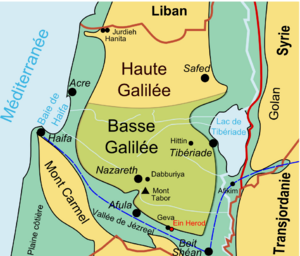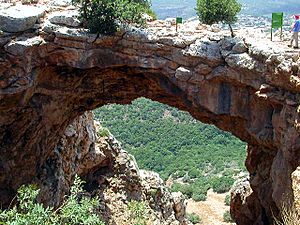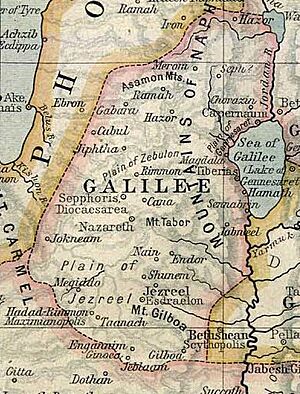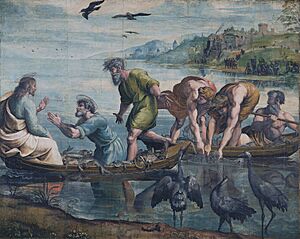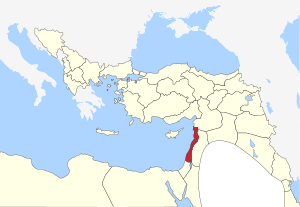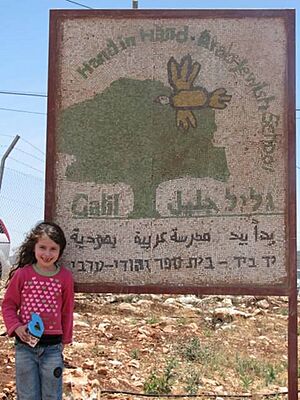Galilee facts for kids
Galilee (pronounced Gal-ih-lee) is a large and important area in northern Israel. It's often thought of as two main parts: Upper Galilee and Lower Galilee. This region is mentioned many times in the New Testament of the Bible, making it a very famous place.
Contents
Geography of Galilee
Most of Galilee has rocky hills and mountains, usually between 500 and 700 meters (about 1,600 to 2,300 feet) high. Some tall mountains are found here, like Mount Tabor and Mount Meron. These mountains have cooler temperatures and get a lot of rain.
Because of this climate, many different kinds of plants and animals live and grow well here. Lots of birds also fly through Galilee every year. They travel from colder places to Africa and then back again.
Galilee has many streams and beautiful waterfalls, especially in Upper Galilee. You can also see huge green fields and colorful wildflowers. Many towns in Galilee are important because of their history from the Bible. All these things make Galilee a very popular place for tourists to visit.
The Upper Galilee gets a lot of rain (900–1200 mm or 35–47 inches). Its mountains are high (Mount Meron is over 1,000 meters or 3,300 feet tall). This means it has special plants and animals. You might find prickly juniper trees, Lebanese cedar trees (a small group grows on Mount Meron), cyclamen flowers, and paeonia flowers.
History of Galilee
Ancient Times
The Bible says that the Israelites gave Galilee its name. It was the land of the Naphthali and Dan tribes. Sometimes, it also included land from the Asher tribe. The Tribe of Dan was known for helping with local laws and justice for the whole nation. So, Galilee was often just called Naphthali.
The First Book of Kings says that Solomon gave twenty cities in Galilee to his friend, King Hiram I of Sidon. These cities might have been settled by people from other lands. Or, they might have been settled by people who were forced to move there by later conquerors like the Assyrians. King Hiram called this area "the land of Cabul" for a while.
During Roman times, the kingdom of Judea was split into different parts. Galilee was the largest northern part. After Judea became a Roman province in 6 CE, Galilee was briefly part of it. Then it became separate for about 200-300 years.
Galilee is believed to be where Jesus lived for at least 30 years of his life. The first three Gospels in the New Testament tell us that Jesus did much of his public work here. He spent time in towns like Nazareth and Capernaum. Galilee is also where Jesus performed many miracles, like healing a blind man. After Jesus died, some stories say his disciples returned to Galilee. They experienced His resurrection there.
Many important Jewish teachers, called Tannaim, also lived in Galilee. Their ideas are written in the Mishnah and Talmud. Some of these teachers include Honi Ha-Ma'agel and Jose the Galilean. People believed that Galilean rabbis could perform miracles. This was different from rabbis in other areas. Many of these teachers had lots of students and followers. Galilee was known for its miracle workers and wise thinkers, especially before the big split between Jesus' followers and those who did not follow him.
According to the Talmud, Johanan ben Zakai, a very important founder of modern Jewish faith, was born in Galilee. Simeon bar Yochai, another famous teacher, hid from the Romans in Galilee. He dug tunnels to stay safe. Many miracles are linked to him during his time in Galilee. Some legends say he wrote the Zohar there.
Old synagogues found in Galilee show influences from Phoenicia and Rome. They also show that people were more accepting of other cultures there. Eastern Galilee kept a Jewish majority until at least the 7th century.
Middle Ages
When the Arab caliphate took control in 638, Galilee became part of a district called Jund al-Urdunn (District of Jordan). Important towns included Tiberias (the capital), Baysan, Acre, Saffuriya, and Kabul.
The Shia Fatimids took over in the 10th century. A group that broke away from them, called the Druze, formed their religion. Their main centers were in Mount Lebanon and parts of Galilee. During the Crusades, Galilee became the Principality of Galilee, an important Crusader area.
Ottoman Era

During the early Ottoman period, Galilee was governed as the Safad Sanjak. It was part of a larger area called Damascus Eyalet. Later, it became part of Sidon Eyalet. In the 18th century, Galilee's administration changed to Acre Sanjak. The main city became Acre.
More Jewish people moved to Galilee after they were forced out of Spain by the Alhambra Decree. The Ottoman Empire welcomed them. For a while, the city of Safed became a global center for making cloth and for Jewish learning. Today, Safed is still one of Judaism's Four Holy Cities and a center for kabbalah (Jewish mysticism).
In the mid-17th century, Galilee and Mount Lebanon saw a struggle for power among the Druze. This caused a lot of damage and led to the decline of major cities.
In the mid-18th century, Galilee was part of a fight between the Arab leader Zahir al-Umar and the Ottoman rulers. Zahir ruled Galilee for 25 years. Then, an Ottoman leader named Jezzar Pasha took control in 1775.
In 1831, Galilee was part of Ottoman Syria. It was taken over by Ibrahim Pasha of Egypt until 1840. During this time, new rules were put in place that led to a violent Arab revolt in 1834. During this revolt, the Jewish community in Safed suffered greatly. The Arab rebels were later defeated by Egyptian soldiers. However, in 1838, the Druze in Galilee started another uprising. In 1834 and 1837, big earthquakes destroyed most towns, causing many deaths.
After reforms in the Ottoman Empire in 1864, Galilee stayed in Acre Sanjak. It was moved from Sidon Eyalet to the new Syria Vilayet. From 1888, it was managed from Beirut Vilayet.
In 1866, Galilee's first hospital, the Nazareth Hospital, was started. Dr. Kaloost Vartan led this effort, with help from John Zeller.
In the early 1900s, Galilee was still part of Acre Sanjak in Ottoman Syria. It was the southernmost part of the Beirut Vilayet.
British Rule and Israeli Control
After the Ottoman Empire lost World War I, Galilee came under British rule. It was part of the British Mandate for Palestine starting in 1923.
After the 1948 Arab–Israeli war, almost all of Galilee came under Israel's control. Many people left or were forced to leave, and dozens of villages became empty. However, a large Israeli Arab community stayed. They lived in and near cities like Nazareth, Acre, Tamra, Sakhnin, and Shefa-'Amr. This was partly due to good relations with the Druze people. The kibbutz communities around the Sea of Galilee were sometimes attacked by the Syrian army until Israel took the Golan Heights in the 1967 Six-Day War.
In the 1970s and early 1980s, the Palestine Liberation Organization (PLO) launched attacks on towns in Upper and Western Galilee from Lebanon. Israel started Operation Litani (1979) and Operation Peace For Galilee (1982). Their goals were to destroy the PLO in Lebanon and protect people in Galilee. Israel occupied much of southern Lebanon until 1985. Then, they pulled back to a small security area.
Until 2000, Hezbollah and earlier Amal continued to fight the Israeli Defence Forces. They sometimes fired Katyusha rockets at communities in Upper Galilee. In May 2000, Israeli prime minister Ehud Barak pulled Israeli troops out of southern Lebanon. They stayed on the Israeli side of the border, which is recognized by the United Nations. However, fighting between Hezbollah and Israel continued along the border. UN observers criticized both sides for their attacks.
The 2006 Israel-Lebanon conflict involved constant Katyusha rocket attacks by Hezbollah on all of Galilee. These rockets had a much longer range. They hit as far south as the Sharon Plain, Jezreel Valley, and Jordan Valley below the Sea of Galilee.
People of Galilee
The biggest cities in Galilee are Acre, Nahariya, Nazareth, Safed, Karmiel, Shaghur, Shefa-'Amr, Afula, and Tiberias. The port city of Haifa is a business center for the whole region.
Because Galilee is so hilly, most people live in small villages. These villages are connected by only a few roads. A train line runs south from Nahariya along the Mediterranean coast. Another part of the line goes east and opened in 2015. The main ways people earn a living are through farming and tourism. New industrial parks are being built, which create more jobs for local people, including many new immigrants. The Israeli government is helping to fund a project called the Galilee Finance Facility.
Galilee is home to many Arab people. Most of them are Muslim. There are also two smaller groups: Druze and Arab Christians. Both of these groups have most of their people living in Galilee. Other smaller groups include the Bedouin, the Maronites, and the Circassians.
The north-central part of Galilee is called Central Galilee. It stretches from the border with Lebanon to the northern edge of the Jezreel Valley. This area includes Nazareth and Sakhnin. It has an Arab majority of 75%. Most Jewish people live in hilltop cities like Upper Nazareth. The northern half of the central Lower Galilee, around Karmiel and Sakhnin, is known as the "Heart of the Galilee."
Eastern Galilee is almost entirely Jewish. This part includes the Finger of the Galilee, the Jordan River Valley, and the shores of the Sea of Galilee. It has two of Judaism's Four Holy Cities. The southern part of Galilee, including the Jezreel Valley and the Gilboa region, is also almost entirely Jewish. There are a few small Arab villages near the West Bank border. About 80% of the people in Western Galilee are Jewish, all the way up to the Lebanese border. Jewish people also make up a small majority in the mountainous Upper Galilee. This area also has a significant number of Arab people, mainly Druze and Christians.
The Jewish Agency has tried to increase the Jewish population in this area. However, the non-Jewish population also grows quickly. As of 2006, there were 1.2 million people living in Galilee. About 46.9% of them were Jewish.
Today, many Haredi Jews are moving to Galilee and the Negev desert. They are doing this because housing prices are very high in central Israel.
Tourism in Galilee
Galilee is a popular place for both local and international tourists. People enjoy its beautiful scenery, fun activities, and delicious food. Many Christian pilgrims visit Galilee. This is because many of the miracles of Jesus happened on the shores of the Sea of Galilee, according to the New Testament. These include Jesus walking on water, calming the storm, and feeding five thousand people in Tabgha.
Also, many places important to the Bible are in Galilee. These include Megiddo, Jezreel Valley, Mount Tabor, Hazor, and Horns of Hattin.
A popular hiking path called the yam leyam (sea-to-sea) starts at the Mediterranean Sea. Hikers then walk through the Galilee mountains, including Tabor, Neria, and Meron. Their journey ends at the Kinneret (Sea of Galilee).
In April 2011, Israel opened the "Jesus Trail." This is a 40-mile (60-km) hiking trail for Christian pilgrims in Galilee. The trail has footpaths, roads, and bike paths. It connects places important to the lives of Jesus and his disciples. These include Tabgha, where Jesus is said to have performed the miracle of the loaves and fishes. It also includes the Mount of Beatitudes, where he gave his Sermon on the Mount. The trail finishes at Capernaum on the shores of the Sea of Galilee, where Jesus taught his lessons.

Many kibbutz and moshav families offer Zimmern (which means "rooms" in German, but here it means bed and breakfasts). Many festivals happen throughout the year, especially in autumn and spring. These include the Acre (Acco) Festival of Alternative Theater, the olive harvest festival, and music festivals. There are also festivals for Anglo-American folk music, klezmer music, Renaissance music, and chamber music. The Karmiel Dance Festival is also very popular.
Cuisine of Galilee
The food in Galilee is very varied. Meals are often lighter than in the central and southern parts of Israel. Dairy products are eaten a lot, especially the Safed cheese that comes from the mountains of the Upper Galilee. Herbs like thyme, mint, parsley, basil, and rosemary are very common. They are used with everything, including dips, meat, fish, stews, and cheese.
In eastern Galilee, fresh water fish is eaten as much as meat. This includes tilapia, which lives in the Sea of Galilee, the Jordan River, and other streams. Fish is often filled with thyme and grilled with rosemary for flavor. Or, it might be stuffed with oregano leaves, topped with parsley, and served with lemon. This way of cooking fish is also found in other parts of the country, like the Mediterranean and Red Sea coasts. A special dish from the region is baked tilapia flavored with celery, mint, and lots of lemon juice. Baked fish with tahini is also common in Tiberias. People on the coast prefer to use yogurt instead of tahini and add sumac on top.
Galilee is famous for its olives, pomegranates, wine, and especially its Labneh with Za'atar. This is served with pita bread. Meat stews with wine, pomegranates, and herbs like akub, parsley, khalmit, mint, and fennel are common. Galilean kubba is usually flavored with cumin, cinnamon, cardamom, strong pomegranate juice, onion, parsley, and pine nuts. It is served as a small dish with tahini dip.
Kebabs are made in a similar way, but with sumac instead of cardamom. Sometimes carob is used instead of pomegranate juice. Because of the climate, beef has become more popular than lamb, but both are still eaten. Dates are popular in the warm climate of Eastern Galilee, just like in other eastern parts of the country.
Images for kids
-
Herod Antipas was a Roman ruler of Galilee from 4 BCE to 39 CE. He was allowed to make his own coins, like the one shown here.
See also
 In Spanish: Galilea para niños
In Spanish: Galilea para niños


